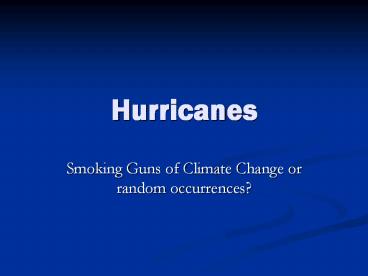Hurricanes PowerPoint PPT Presentation
Title: Hurricanes
1
Hurricanes
- Smoking Guns of Climate Change or random
occurrences?
2
Climate Change and Chaotic Dynamics Hurricane
Example
- Naive expectation is that steadily rising sea
surface temperatures (SST) should produce
increasingly strong hurricanes - After 2005 Katrina, Rita and Wilma there was a
rash of papers on how increasing hurricane
strength was now a manifestation of global
climate change - Needs reality check
3
Atlantic Hurricane Formation
- Low pressure centers form over Sahara desert and
may get amplified as they cross open ocean - Amplification depends critically on SST and
available moisture in the atmosphere - Must also have favorable wind conditions (light
winds aloft) and weak wind shear - It is not just SST that drives hurricanes
4
Hurricane Frequency Increasing?
- This is difficult to establish with a high degree
of statistical confidence Incompleteness is an
important issue
5
Counting is always noisy
Yellow raw data Red corrected
RADAR in the 1950s
6
Landfall Frequency vs Decade
landfall total proportion
1900 27 40 0.675
1910 29 37 0.78378378
1920 25 42 0.5952381
1930 36 47 0.76595745
1940 34 50 0.68
1950 34 69 0.49275362
1960 26 61 0.42622951
1970 23 49 0.46938776
1980 21 52 0.40384615
1990 24 64 0.375
2000 40 74 0.54054054
585
1900-1949 151 216 0.69907407
1950-2009 168 369 0.45528455
7
Using landfall frequency as a proxy
- Shows that significant incompleteness (25-50)
exists in the pre-radar era - There is no reason to the frequency of Atlantic
basin hurricanes to have any systematic in their
decade averaged land fall frequency. - This makes it pretty clear that hurricanes are
not increasing in frequency in response to slow
rise of SST. - Decadal variations are much larger than any
systematically increasing baseline
8
Hurricane Energetics
- Total amount of energy release as latent heat
(condensation of water droplets) - The amount of kinetic energy needed to maintain
the hurricane wind field (and overall movement)
9
Latent Heat
- Hurricane produces 2 cm per day averaged over a
radius of 600 km - Volume of rain 1016 cm3/day 1016 grams per
day - Latent heat of vaporization is 2475 KJ/Kg (at
typical hurricane temperature) - Gives 2.5 x 1016 Joules/per day or 3 x 1014
Watts (300 TW !!!)
10
Kinetic Energy
- KE generated amount dissipated due to friction
- Dissipation Rate per unit area air density
drag coefficient velocity3
Ro is some characteristic outer radius which is
largely unknown for pre-satellite hurricanes.
11
Energetics
- Suitable averages over wind velocities (90 mph
over a scale of 60 km) yields 1.5 TW of kinetic
power - The total energy output of the world in all forms
is 14 TW - 14 is bigger than 1.5 but not bigger than 300
- Which energy scale is most relevant for hurricane
formation and evolution? If 300 then humans are
doing squat.
12
What does Data Tell us?
- A Central Pressure
- A hurricane wind radius (quite variable)
- A duration
- A location (time dependent)
- An evolutionary timescale (spin up times)
- Category X at landfall
13
Decadal Location Analysis only 1 region shows
upward systematic trend in counts per decade per
cell
14
Central Pressure Evolution
15
But strongest storms may be increasing
Note that 2009 was weakest Atlantic Basic
Hurricane Season over the last 20 years 2005 was
the strongest
16
Strong Decadal Location Variability on spatial
scale of 3x3 degrees
17
Spin up Times getting faster
This is a Physical Signature associated with
change in convection rates but data has to
support this conjecture.

